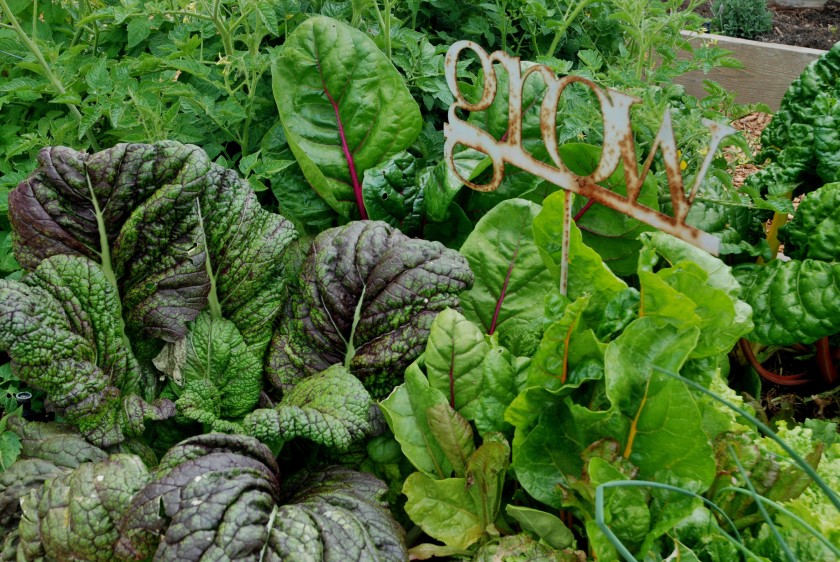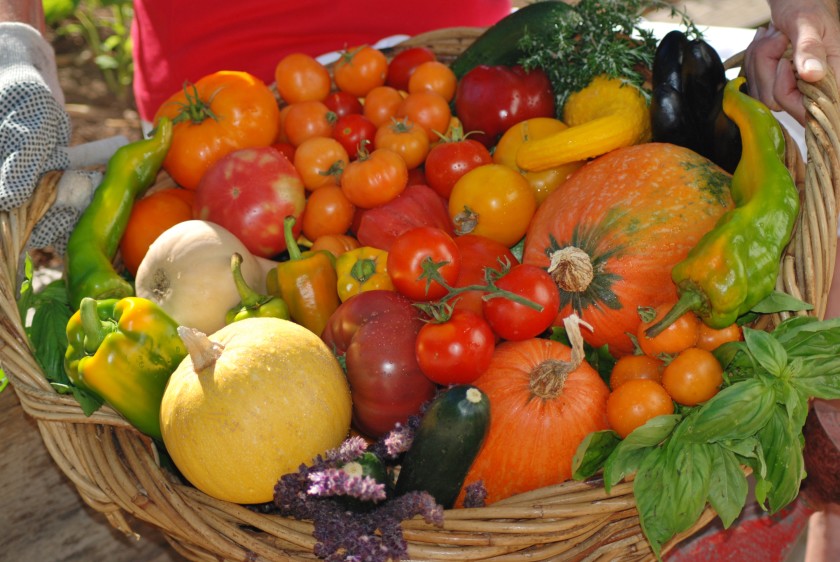When, What, How Often to Harvest

Periodically pick a few leaves of lettuce, kale and other leafy greens, and the plants will keep growing.(Meredith French / UCCE San Diego County Master Gardener)
By DONNA MCCLAY
As spring gives way to the lazy days of summer, we can hardly wait to savor that first juicy tomato from the garden. Most backyard gardeners know what, when and how to plant our favorite veggies, but we also need to know how and when to harvest them for peak flavor and nutritional value.
Many factors are at play in knowing the proper way to pick fruits and vegetables from our home gardens:
When to harvest
How long does it take the plant to reach maturity? Seed packets and plant tags usually list the number of days to maturity as a guide, but you should also be familiar with the signs of ripeness — firmness, color and smell. Some vegetables and fruits continue to ripen after harvesting; others do not.
What to harvest
Are some parts of the plant edible and some toxic? Some summer squashes like zucchini have edible blossoms, and beet greens are delicious sautéed or added to salads. On the other hand, the green, leafy parts of rhubarb should never be eaten because they are poisonous.
How often to harvest
What plants continue to grow after harvesting? Lettuce, kale and other leafy greens fall into the “cut and come again” category because you can pick a few leaves at a time and they will continue to grow. Herbs can be pinched back to encourage more growth, as well. Cauliflower, however, is a “one and done” vegetable, as each plant produces just a single head.
When harvesting ends
Be aware of “bolting.” Bolting occurs when flowers develop too quickly in response to changes in temperature and other seasonal fluctuations. When a plant bolts, all of the energy is concentrated into producing the flowers. Many cool season vegetables, such as broccoli and lettuce, cannot tolerate the heat of summer and will bolt. Green, leafy vegetables that have bolted will taste bitter and are not very appetizing. Once a plant has bolted, you can pinch off the flowers and dry them out if you want to collect the seeds and save them for planting next year.
The best time to harvest is as early in the day as possible, especially if you don’t plan to eat what you pick right away. This is because as soon as the sun rises, the inner or pulp temperature begins to rise. Harvesting during the coolest part of the day extends the freshness and shelf life of produce. Tomatoes, in particular, become mushy and lose flavor when they are harvested during warm temperatures and refrigerated. Pick your tomatoes in the morning and store them on the counter in a basket, out of direct sunlight.

The best time to harvest is as early in the day as possible, especially if you don’t plan to eat what you pick right away. This is because as soon as the sun rises, the inner or pulp temperature begins to rise. Harvesting during the coolest part of the day extends the freshness and shelf life of produce. (Meredith French / UCCE San Diego County Master Gardener)
Other vegetables such as corn and peas are best cooked and eaten soon after harvesting, because they begin to convert sugar to starch as soon as they are picked and will lose flavor. The same is true for citrus — better to eat them soon after picking, otherwise it’s best to leave citrus on the tree and don’t harvest more than you need each time. Check plants for maturity at least every other day during the summer. A good rule of thumb is to only harvest what you plan to eat in the next day or two.
Daily harvesting as vegetables reach maturity guarantees that you are picking them at peak tenderness and flavor. You will also be able to spot problems before the entire plant is damaged. Remove dead leaves and rotting fruit frequently to discourage pests, and to keep the plant from expending energy on something you can’t eat. Toward the end of summer, pinch off the last blossoms of peppers, melons, squash and tomatoes. That will redirect the plant’s energy to maturing fruits that have already set.
Special tools are not necessary for harvesting most vegetables. Hand picking leafy greens, herbs, peas and beans is the best way to harvest them. You may want to use a sharp knife or garden shears to make a clean, sharp cut on zucchini, tomatoes, cucumbers and corn. Using the proper tool prevents damage to the plant, thus preventing an entry point for unwelcome pests and diseases. Use a large garden colander or vinyl tub to wash off the first layer of soil before bringing your harvest indoors. And remember to practice basic hygiene and food safety as you harvest — clean hands, tools and equipment are essential to preventing foodborne illness.
Flavor in fruits and vegetables is a reflection of the quality at harvest and how they are stored. Proper home storage is important to maintain optimum freshness and flavor. Many types of produce are best stored at room temperature, including tomatoes, sweet potatoes and melons. And what about those crisper drawers in the refrigerator? Generally speaking, use a low humidity setting for things that rot (think stone fruit, cucumbers and zucchini), and a high humidity setting for things that wilt (like asparagus, leafy greens, herbs and lettuces). The crisper drawers work best when they are only two-thirds full.
If you want to learn more about growing your own fruits and vegetables at home, check out the Beginning Vegetable Gardening content at mastergardenersd.org/beginning-vegetable-gardening.
McClay is a UCCE Master Gardener and teaches Beginning Vegetable Gardening workshops at the Mira Mesa Community Garden. Get live gardening advice on the Master Gardeners’ hotline, (858) 822-6910, from 9 a.m. to 3 p.m. on weekdays.

